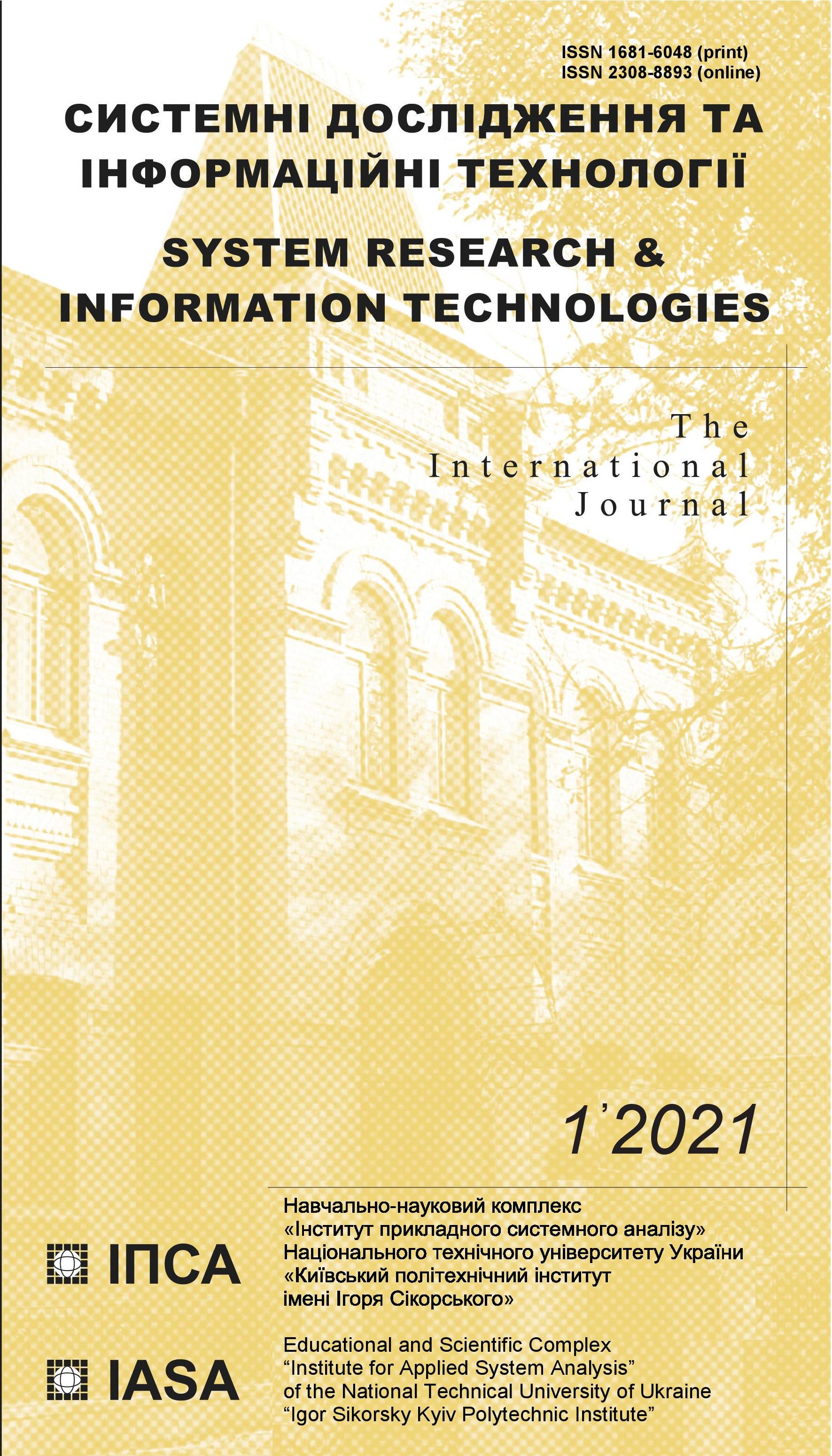Quintile regression based approach for dynamical VaR and CVaR forecasting using metalog distribution
DOI:
https://doi.org/10.20535/SRIT.2308-8893.2021.1.12Keywords:
VaR, CVaR, Expected Shortfall, dynamic risk measures, forecast, Quantile LGARCH model, metalog distributionAbstract
The paper proposes a new method of dynamic VaR and CVaR (ES) risk measures forecasting. Quantile linear GARCH model is chosen as the main forecasting model for time series quantiles. To build a forecast, the values of quantiles are approximated by the metalog distribution, which makes it possible to use analytical formulas to evaluate risk measures. The method of VaR and CVaR forecasting is formulated as a step-by-step algorithm. At the first stage, an initial model is built to obtain variance estimates. The predicted variance values obtained from the constructed model are used at the second stage to find the QLGARCH model coefficients by solving the minimization problem. At the third stage, the QLGARCH models are estimated on a non uniform quantile grid. The obtained predicted values of quantiles are used to estimate the approximating metalog distribution. The investigated theory is applied to VaR and CVaR forecasting for time series of daily log return of the DJI index.
References
McNeil R. Frey and P. Embrechts, Quantitative Risk Management: Concepts, Techniques, and Tools. New Jersey, USA: Princeton University Press, 2005.
N. Pankratova and N. Zrazhevska, “Method of dynamic var and cvar risk measures forecasting for long range dependent time series on the base of the heteroscedastic model”, Intelligent Control and Automation, vol.8, pp. 126–138, Jan. 2017. Available: https://doi.org/10.4236/ica.2017.82010
H. Badaye and J. Narsoo, “Forecasting multivariate var and es using mc-garch-copula model”, The Journal of Risk Finance, vol. 21, no. 5, pp. 493–516, 2020. Available: https://doi.org/10.1108/JRF-06-2019-0114
S. Paul and P. Sharma, “Quantile forecasts using the realized garch-evt approach”, Studies in Economics and Finance, vol. 35, no. 4, pp. 481–504, Oct. 2018. Available: https://doi.org/10.1108/SEF-09-2016-0236
Z. Xiao and R. Koenker, “Conditional quantile estimation for generalized autoregressive conditional heteroscedasticity models”, Journal of the American Statistical Association, vol.104, pp. 1696–1712, Dec. 2009. Available: https://doi.org/10.1198/ jasa. 2009.tm09170
R. Koenker, V. Chernozhukov, X. He, and L. Peng, Handbook of Quantile Regression [1st ed.]. Boca Raton, USA: CRC Press, 2017. Available: https://doi.org/10.1201/ 9781315120256
Y. Zheng, Z. Qianqian, G. Li, and Z. Xiao, “Hybrid quantile regression estimation for time series models with conditional heteroscedasticity”, Journal of the Royal Statistical Society: Series B (Statistical Methodology), vol. 80, issue 5, pp. 975–993, Nov. 2018. Available: https://doi.org/10.1111/rssb.12277
G. Wang, K. Zhu, G. Li, and W.K. Li, “Hybrid quantile estimation for asymmetric power garch models”, Journal of Econometrics, Aug. 2020. Available: https: //www.sciencedirect.com/science/article/abs/pii/S0304407620302220, Accessed on: 6 August 2020. Available: https://doi.org/10.1016/j.jeconom. 2020.05.005.
T. Keelin, “The metalog distributions”, Decision Analysis, vol. 13, issue 4, pp. 243–277, Dec. 2016. Available: https://doi.org/10.1287/deca.2016.0338
J. Wang, M. Neil, and N. Fenton, “A bayesian network approach for cybersecurity risk assessment implementing and extending the fair model”, Computers & Security, vol. 89, 2020. Available: https://doi.org/10.1016/j.cose.2019.101659
P. Dion, N. Galbraith, and E. Sirag, “Using Expert Elicitation to Build Long-Term Projection Assumptions”, in Developments in Demographic Forecasting. The Springer Series on Demographic Methods and Population Analysis, vol. 49, Springer, Cham, 2020, pp. 43–62. Available: https://doi.org/10.1007/978-3-030-42472-5_3
R. Bratvold, E. Mohus, D. Petutschnig, and J. Bickel, “Optimistic and Overconfident—Over and Over Again”, SPE Reservoir Evaluation and Engineering, vol. 23, May 2020. Available: https://doi.org/10.2118/195914-PA
V. Zrazhevska and G. Zrazhevsky, “Generalized approach for estimating and forecasting of dynamical var and cvar based on metalog distribution”, Lecture Notes in Computational Intelligence and Decision Making, in Babichev S., Lytvynenko V., Wójcik W., Vyshemyrskaya S. (eds), ISDMCI 2020. Advances in Intelligent Systems and Computing, vol. 1246. Springer, Cham. Available: https://doi.org/10.1007/978-3-030-54215-3_15
N.G. Zrazhevskaja and A.G. Zrazhevskij, “Classification of methods for risk measures var and cvar calculation and estimation”, System research and information technologies, vol. 3, pp. 118–125, Sep. 2016. Available: https://doi.org/10.20535/ SRIT. 2308-8893.2016.3.11
A. Ghalanos, Introduction to the rugarch package (Version 1.4-3). Available: https://cran.r-project.org/web/packages/rugarch/vignettes/Introduction_to_the_rugarch_ package.pdf [July 15, 2020]
R. Koenker, Quantile regression in R: a vignette. Available: https://cran.r-project. org/web/packages/quantreg/vignettes/rq.pdf [June 28, 2019].
G. Zrazhevsky, A. Golodnikov, S. Uryasev, and A. Zrazhevsky, “Application of buffered probability of exceedance in reliability optimization problems”, Cybernetics and Systems Analysis, vol. 56, pp. 1–9, May 2020. Available: https://doi.org/10. 1007s10559.020.00263.4
N. Nolde and J.F. Ziegel, “Elicitability and backtesting: Perspectives for banking regulation”, The Annals of Applied Statistics, vol. 11, no. 4, pp. 1833–1874, 2017. Available: https://doi.org/10.1214/17-AOAS1041
S. Bayer and T. Dimitriadis, “Regression-Based Expected Shortfall Backtesting”, Journal of Financial Econometrics, September, 2020. Available: https://academic.oup.com/jfec/advance-articlepdf/doi/10.1093/jjfinec/nbaa013/33796824/nbaa013.pdf, Accessed on: 27 April 2020. Available: https://doi.org/10.1093/jjfinec/nbaa013

